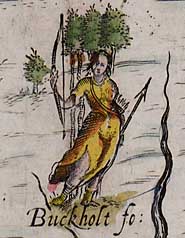|
|
Work in progress The Report for 2007-9 to the Marc Fitch Fund stated: ‘One unexpected outcome of the research is that it is now clear that the number of identified forests and chases is far from exhausted’. That includes Wales, which has proved the most difficult area to address, both in terms of numbers and location and in relating it to the overall narrative and interpretation, because of the peculiarities encountered. Indeed, much more work still needs to be done to illuminate and explicate those peculiarities. Jack Langton has begun by making a further systematic trawl of evidence, starting with published sources, often difficult to come by and for orthographic and other reasons difficult to fit into the existing picture. It is expected to be the middle of 2010 before a position is reached to draw conclusions. However, it can already be asserted confidently that the conclusions are likely to add significantly to what is known and understood about forests and chases and similar areas in Wales such as ffriths. What will come directly is an article for a refereed journal (Langton), and revision of the existing mapping from 2007-9 on the basis of the additional research, together with maps to accompany the article (Jones). Graham Jones will continue to be funded by St John’s College until the end of June, 2010 [He subsequently continues at the College, self-funded]. However, though the rate of new discoveries elsewhere and the consequent revisions have abated to a comparative trickle, and the continued systematic collation and mapping of new material and concurrent work on Wales is expected to be complete by summer 2010, the work will then have reached a stage where it is possible and necessary that a definitive statement can be made for hard copy publication. That is intended to be in the form of an atlas of the nearly 1,000 forests and chases so far identified, to be prepared over two years from October 2010. It will culminate and consolidate the proposals set out in John Langton and Graham Jones (eds), Forests and Chases of England and Wales, c.1500 to c.1850 (Oxford, St John’s College, 2005) and developed in their Forests and Chases of Medieval England and Wales, c.1000-c.1500 [published in 2010]. A demonstration that at their maximum forests and chases covered about half of the country, including five whole counties, will correct a very obtrusive historical deficiency: it is customarily said that there were about 100 in medieval times, and sixty-odd by the seventeenth century; maps as recent as Stephen Mileson, Parks in Medieval England (OUP, 2009) reproduce that drawn in 1921 by Bazeley for the mid-thirteenth century, with 65 forests. At the same time, the atlas will inform landscape planners, policy makers and public debates about the conservation and renewal of natural resources: most of the areas devoted to National Parks and Areas of Outstanding Natural Beauty were forests or chases until very recent times (royal forests were invested in the Forestry Commisssion in 1919, and the Charter [1217] and Ordinances [1306] of the Forest were still extant until the Forest Laws in general were abrogated in 1971). After explaining the provenance and content of the maps, an Introduction and Commentary of 30,000 words will stress the great extent and long-survival of these areas where a monopoly of hunting and rights to protect wild animals and vegetation (‘venison and vert’) was created by sovereign powers (earls and bishops as well as kings) over their own land, waste, and land possessed and used by others, privately or in common, for all other purposes. It will also shift attention from customary concerns with the perceived need to eradicate forests and chases as products of arbitrary power, preventing economic development on fully privatised property, to an appreciation of their existence as common-pool resource systems with regulated multiple overlapping rights of usage. The maps will contextualise and illustrate these proposals as follows: (A) The Introduction will contain small scale index maps which starkly demonstrate the true extent of forests and chases, and a number of thematic maps (e.g. forests at different times; relative to geology and settlement form; those for which there were eyres; with industrial resources; with Acts of disafforestation).(B) 22 regional maps covering the whole of England and Wales will show features such as boundaries at their fullest extent; lordship; industrial resources; county boundaries, and major towns, abstracted from enhanced versions of the 114 multi-layered cartographic files (in CorelDraw) already overlaid on the Kain and Oliver pre-1850 parishes and townships atlas (with OS one-inch-to-the-mile sheets as background) with a Marc Fitch Special Research Project Grant and matching funding from St John’s College (2007-9), and published on the project web-site /forests. (C) 20 maps with explicatory captions will show individual forests at larger scales and greater levels of complexity (e.g. boundaries through time; internal parts; parks; lodges, commons, squatters, industry), some accompanied by facsimiles of early maps. A summary Gazetteer will be supplemented by the applicant’s full working data-set, provided on a CD disk in a back cover pocket: An Excel spreadsheet file currently with 975 records organised by county and 52 fields (including published and archival sources and other aids to identification, earliest record and other significant dates, lordship, courts, officials, date of disafforestation etc).
|
